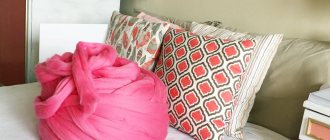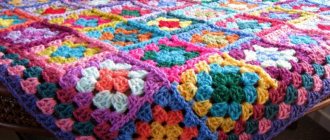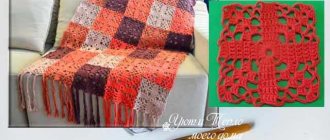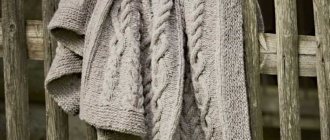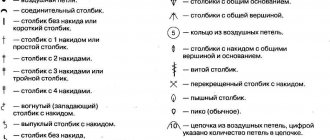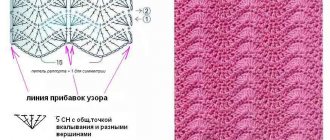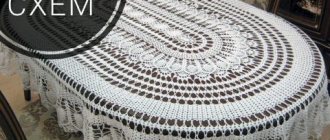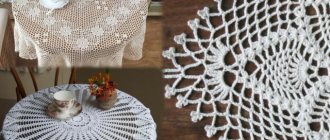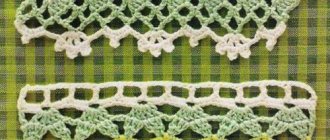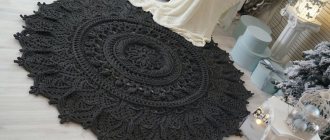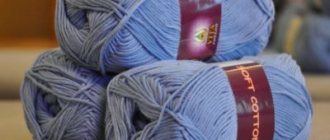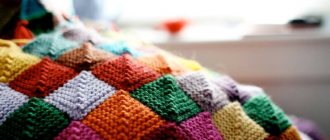Correctly chosen yarn for a blanket is the key to successful knitting, the desired result and the durability of the product.
In order not to make a mistake with the choice of threads, you must first decide on the model and design of the future bedspread, determine the knitting method, the tool and the purpose of the item. Let's consider the main criteria that need to be followed. It is especially important not to make a mistake when wanting to knit a blanket for a baby or an envelope for a newborn with your own hands.
- Basic criteria for choosing yarn for knitting a blanket
- Knitting pattern
- Purpose is not the last criterion
- Season is an important guide
- Knitting duration
- Selecting yarn for knitting a blanket, taking into account its characteristics
- Cotton threads
- Wool yarn
- Plush for fluffy things
- The choice of yarn depending on the chosen knitting technique
- Purposes of the blanket
- The choice of threads depending on the knitting tool
Basic criteria for choosing yarn for knitting a blanket
You cannot choose a material only by color and price - there are more important criteria that should come first.
Knitting pattern
This is perhaps the most important factor influencing the choice of suitable yarn. Not every thread can be used to create the intended motif. The simplicity and ease of knitting and, as a result, the pleasure of working depend on the right decision.
If you like openwork motifs , you should choose thin threads with little fluff or without it. A slight fluffiness of the yarn can hide inaccuracies and errors in work; the fluff gives the blanket additional softness and is pleasant to the skin. But it smooths out the pattern and hides the openwork underneath, so you should not use this yarn when clear lace lines are required.
Also, you should not buy yarn with fuzz for knitting baby blankets and blankets for babies. Fluff can get on the baby's face, disturb him during sleep, cause irritation, itching and cause a lot of other troubles.
Volumetric weaves and braids look more impressive if made using threads of medium thickness. It is most practical to choose wool threads.
To create patterned motifs using the Patchwork technique, yarn of any thickness and color is suitable. Most often, threads of different colors are used in one product. It is important to remember that the yarn chosen for such a blanket must be the same in thickness and material .
It is not advisable to combine thin threads with thick ones, wool with cotton, etc. The different properties of the threads will not have the best effect on the appearance of the finished product and will complicate its care in the future.
Purpose is not the last criterion
An important factor in choosing yarn is the household purpose of the blanket. It is important to remember here that the lighter the finished product, the more versatile it will be.
Lightweight models can be used instead of bedspreads and covers on sofas, beds and armchairs. If necessary, you can hide with them while sleeping or wrap yourself up after a winter walk, sitting comfortably by the fireplace.
Blankets made from thick yarn are quite heavy, sometimes reaching a weight of more than three kilograms. These are often chosen as decorative interior elements: bedspreads, covers and rugs. The finished product is thick enough to lay the blanket on the floor.
For children's blankets, predominantly fine types of yarn are chosen. Light, almost weightless blankets easily fit into a crib or stroller. They are convenient to use as an envelope, wrapping your child before going for a walk. Read more about kid-friendly yarn here.
Season is an important guide
When choosing yarn for knitting a blanket with your own hands, you should take into account the season in which you plan to use it. So, when creating a bedspread for cool summer nights, cotton threads . But here it is important to remember that specially treated mercerized cotton has a rather rigid structure, so it is better not to choose yarn with this property.
Blankets for rainy autumn evenings are best made from thin woolen threads. Such a blanket will serve as an excellent bedspread, bring coziness to the house and, if necessary, warm the body, sitting comfortably on the shoulders.
For the winter season, warm blankets are knitted from medium-thick wool threads using voluminous weaves and braids. Such motifs make the products softer and more structured, which allows them to retain more air, making them even warmer. For decorative purposes, you can choose warm-colored yarn to make a winter blanket.
Knitting duration
Another important aspect when choosing yarn for a blanket is the duration of the work. Everyone determines this factor for themselves depending on their temperament, free time and skill level.
Making complex openwork motifs from thin threads requires much more time than weaving with garter stitch from large yarn. Making a lace blanket from the finest merino wool can take months of work. While weaving giant yarn by hand takes several hours.
Selecting yarn for knitting a blanket, taking into account its characteristics
By using the right material for the chosen blanket model, you can achieve excellent results. But to understand whether the thread will fit well in the pattern, you need to take into account the main characteristics of knitting threads.
Cotton threads
Cotton is often used to create lace motifs. Its thread is quite soft and obedient, the weaving is dense. When working, it does not fluff up, lies flat and allows you to create openwork designs of extraordinary beauty and clarity. This is an excellent yarn for newborns; it is chosen for knitting children's holiday blankets for discharge.
Mercerized cotton threads have a more rigid structure and a light natural shine to the surface. A blanket made from such yarn will be more dense and “spiky”, will hold its shape perfectly and can be easily cleaned of dirt. However, the use of such yarn for creating children's blankets is not advisable, since the rigid structure is not very pleasant to the body and can irritate delicate children's skin.
In addition to cotton, you can successfully use bamboo and linen yarns. At the same time, we must not forget that each thread has its own unique structure and, before purchasing a complete set, it is necessary to correctly evaluate its properties on a small test sample.
Wool yarn
Wool is a universal material for knitting blankets. A huge assortment and a wide variety of wool threads allow you to create blankets of almost any thickness and density.
Finer types of wool knitting threads are chosen to create the finest lace bedspreads. Merino wool is the softest . It has a delicate structure and thin, neatly twisted threads. In addition, it is considered completely hypoallergenic and is often used to create blankets and envelopes for the youngest users.
Alpaca and Angora rabbit wool has downy threads. They give the product extraordinary softness and a delicate, pleasant-to-touch surface. This blanket will perfectly complement the interior, warm you up on a cold evening and add a little warmth and comfort to any home.
Medium-thick sheep's wool yarn is perfect for creating large, voluminous designs. Knitted braids and all kinds of weaving are a win-win option for making a warm blanket. Volumetric patterns give the blanket additional thickness, making it softer and warmer.
Thick, super thick and giant wool threads are a very popular material for creating blankets. The motif of the pattern, as a rule, comes down to ordinary garter stitch, but at the same time the loops turn out to be large, airy and look very impressive. Bedspreads are knitted with the largest knitting needles or simply by hand.
A blanket made from giant yarn has a number of significant disadvantages that every craftswoman who decides to create such a miracle should be aware of:
- thick threads are not twisted into a bundle and feel like cotton wool; during work, the thread can split - this somewhat complicates the knitting process;
- as a rule, the weight of such a bedspread can exceed three kilograms - using it as a blanket or cape is almost impossible;
- the product turns out to be voluminous, which makes caring for it very difficult;
- the high price of the material makes needlework not the most affordable, and the cost of the finished product is several times higher than the cost of such a blanket in the store.
Plush for fluffy things
Plush yarn has an unusual fluffy structure, and the fibers fit so tightly together that they actually resemble faux fur. This is most often made from synthetic acrylic or viscose thread . Sometimes on sale you can find plush thread with the addition of cotton fiber.
Soft blue threads forgive almost any mistakes in knitting. The fabric turns out velvety, very soft and warm. Plush blankets are perfect for the little ones. Very short, dense fibers do not come out of the fabric and do not get into the baby’s face. The products are pleasant to the touch and very warm.
Despite the fact that acrylic and viscose do not cause allergies or irritation on delicate baby skin, you should still remember that synthetics do not allow air to pass through well and can cause diaper rash. You should not leave your child wrapped in such a blanket for a long time.
Turkish yarn Alize Puffy is one of the most interesting solutions among the entire range of plush yarns for blankets. Throughout the entire length of the thread there are a large number of loops, with the help of which weaving occurs.
Knitting a blanket from Alize Puffy does not require special skills, knitting needles or a crochet hook. The whole process occurs with the help of hands and comes down to threading one loop through another. To create a fabric with airy braids and intricate weaves, all you need is desire and quite a bit of practice.
Required materials and tools
Knitted items require high-quality yarn and suitable tools to realize the idea.
The set of tools depends on the method of work. From mega yarn you can knit a large panel using carved methods:
- on the hands (loops are formed manually, throwing them from hand to hand);
- on thick wooden knitting needles (can be found on websites or in specialized stores);
- on plastic tubes with a melted end.
If you knit from regular yarn, you will need knitting needles No. 2.5 No. 3 or No. 4. With thin threads, work with No. 2, No. 2.5 or No. 3.
Important! You should not knit too tightly - this will increase consumption. Very rare knitting looks loose, and in rare patterns this is attractive.
To make some patterns, use a ruler (a wide wooden plank), a special fork or a long hook for Tunisian crochet. It is recommended to choose a familiar way of working that has been practiced before.
The choice of yarn depending on the chosen knitting technique
Experienced craftswomen choose yarn, focusing primarily on the technology for creating a particular model.
Patchwork is a technology for assembling a single fabric from scraps. In the case of knitted blankets, individual related motifs are used, connected to each other. Skilled needlewomen use remnants of thread from past projects.
The motives for the plaid are varied. The entire blanket can be created from threads of one, two or several colors. All the pieces can be the same or completely different - it depends only on the imagination of the master and the desired result.
Both fine and medium-sized yarn are suitable for knitting prefabricated patterns. The main rule when choosing is that all threads must be the same thickness. It is also important to remember that the thicker the thread, the rougher the pattern. Thick thread makes the blanket very heavy and makes the job of sewing the pieces together more difficult.
Bavarian knitting is a technique of crocheting a single fabric from air loops. A distinctive feature is knitting small circles without breaking the thread. By combining different colors with each other, you can achieve very interesting and original designs.
For knitting in this technique, it is best to use thin and medium wool threads. And, if you decide to knit a blanket from multi-colored yarns, you need to choose threads of the same thickness.
The Scandinavian method (double-sided jacquard) is a rather complex type of knitting. The peculiarity of this technique is in the drawing. The blanket is knitted from two threads of different colors. As a result, the chosen motif is clearly visible from both the front and back sides.
This technique can be worked using any type of yarn. Alpaca, merino, and angora rabbit wool are excellent. Blankets knitted from plush yarn look very beautiful.
Openwork and lace blankets are valued for their extraordinary beauty of execution and airy structure. Of course, such work requires a lot of effort, because the perfect pattern is created thanks to the endless patience of the craftswoman. But the result certainly pleases both the needlewoman herself and everyone around her.
There are a huge number of patterns for knitting lace motifs indicating the specific yarn for a particular pattern. The thinnest blankets are made from natural materials, synthetic threads or mixed yarns. You can create lace from thin wool, acrylic and viscose.
The thickness of the yarn may vary depending on the chosen blanket model. Here it is important to take into account one single rule: the tighter the thread is twisted, the clearer the pattern will be. Down lace is a completely different type of openwork; the motif of the design is not clearly visible, but can only be guessed on the canvas, covered with a continuous veil of down.
How to choose
On social networks they often show handmade interior knitwear without patterns, and their eyes widen. There are simple ones in terms of skill and complex ones, real masterpieces. Lots of luxurious bedspreads for the double bed.
How to knit something original? There are 3 options:
- Completely repeat the product you like, repeating the pattern and color.
- Add some variety, according to the available supply of threads.
- Design your own masterpiece using a familiar technique, a beautiful prayer or a pattern of a pattern you like.
Important! Blankets with a circular frame (frame) look more attractive. Fringe, pompoms or handmade tassels will help add sophistication to the product.
Hand knitted fringe
Purposes of the blanket
Different types of blankets are suitable for different household needs. Thus, a yarn that is excellent for a night blanket may be completely inapplicable to a lace bedspread and muslin.
The bedspread is used as a decorative element of the interior. Any type of yarn can be used in its production. It is important to understand that the surface of the blanket will serve as a kind of protective cover for a bed or sofa; it will have to take on all the “blows” of fate.
When choosing yarn for such a blanket, you should pay special attention to the ease of care of the product during operation. The best solution can be all types of synthetic threads: acrylic, viscose, polyamide. Such bedspreads can be easily washed by hand or in washing machines on a delicate cycle and will retain the shape and appearance of a new product for a long time.
The blanket has a number of features that you should pay attention to when choosing yarn. Covering the body at night, it has direct contact with the skin, so it must be breathable and comfortable.
Soft natural threads are best suited for knitting blankets: cotton, merino wool, alpaca, angora. When choosing wool, it is important to pay attention to the softness of the thread; prickly and hard fibers are completely unsuitable for this.
Blankets for newborns can be divided into two groups: a blanket for sleeping and an envelope for walking outside. Based on the application, the yarn is also selected.
Soft merino wool, mixed fabrics, plush with natural fiber are perfect for a warm night blanket. In this case, the use of pure synthetic threads is not permissible, as they do not allow air to pass through well and can cause overheating of the baby and diaper rash on the skin.
An envelope for discharge or a warm blanket for walking can be knitted from any yarn, including synthetic, since it does not have direct contact with the skin and, as a rule, is used instead of outerwear.
Very beautiful models are made from plush threads; such a blanket can be decorated with mischievous bunny ears and a tail. The most important thing is that the decorative elements do not interfere with the child.
How to care
Handmade knitted fabrics are no different. Once finished, they do not need to be washed and steamed like sweaters and blouses.
Washing heavy knitted fabric is problematic due to the large volume of the product. The threads absorb a lot of water, and even after spinning in a centrifuge, the blanket will be heavy. Mega yarn for blankets does not require washing (dry dry cleaning).
Attention! A heavy bedspread should not be crushed too much with your hands, nor should the top be lifted or twisted by hand. It will stretch and lose its shape.
The product is soaked in warm water with liquid soap in the bath, wrung out several times, replacing washing. Then they drain the soapy dirty water without removing the blanket. After rinsing twice with clean water at the same temperature.
A hand-knitted blanket is wrung out in a centrifuge and dried on terry towels in an unfolded form - on the floor or table. Ironing and steaming are not necessary. If the yarn is fluffy, the front side can be lightly fluffed with a brush by quickly hitting a slightly damp surface.
